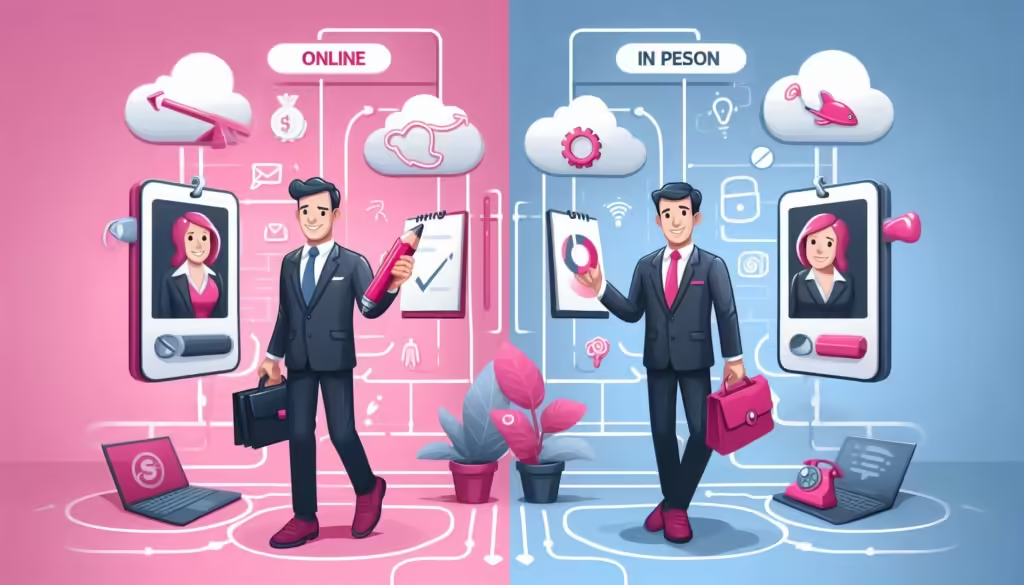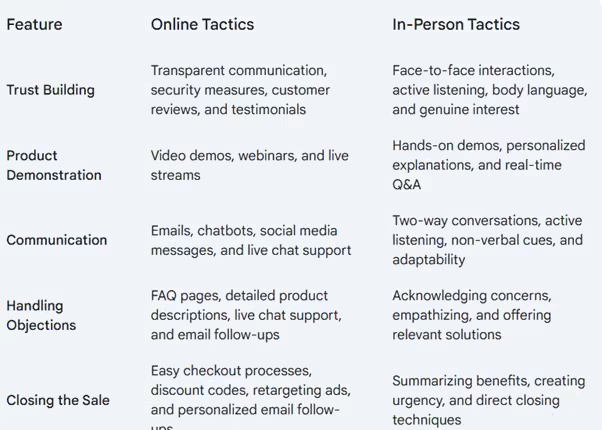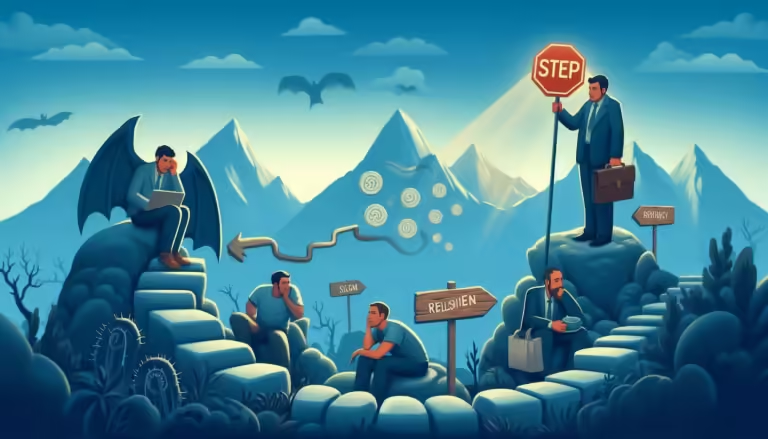Online vs In Person Sales Tactics (10 Points of Difference)

Let’s dive deep into what each method entails, why they matter, and how you can use specific strategies to succeed.


1. Building Trust and Relationships
What it is:
In sales, trust is the foundation of all successful customer relationships. This means creating a sense of comfort and reliability with your buyers.
Why it’s important:
Trust influences buying decisions, particularly when customers have many options to choose from. A buyer is more likely to buy from a salesperson or platform they trust.
How to do it:
- In-Person Tactics:
Face-to-face interactions allow for personal connections. Salespeople can use eye contact, body language, and genuine conversation to build trust. An example of this is a car salesperson who takes the time to understand a customer’s needs and test drives together, building rapport.
Tip: Be authentic, listen more than you speak, and show genuine interest in the customer’s needs.
Case Study:
A study by HubSpot showed that 81% of consumers trust recommendations from people they know. In-person interactions, where relationships are built, are key to such trust-building.
- Online Tactics:
Online trust is built differently. It requires transparent communication, security, and responsiveness. Use customer testimonials, reviews, and prompt replies to inquiries.
Example: E-commerce platforms often display reviews prominently to assure potential buyers about product quality.
Tip: Highlight positive customer reviews and provide live chat support to answer questions instantly.
2. Product Demonstration
What it is:
Demonstrating how a product works gives customers confidence and a better understanding of what they’re buying.
Why it’s important:
Seeing a product in action can reduce doubts and questions, leading to higher chances of making a sale.
How to do it:
- In-Person Tactics:
Salespeople can offer hands-on demos, answer questions live, and personalize the experience. For instance, tech sales representatives often walk clients through product features step by step.
Tip: Tailor the demo to the client’s needs, focusing on the features that solve their specific problem.
Case Study:
Apple’s in-store product demos often result in high conversion rates because customers can see, touch, and experience the product firsthand.
- Online Tactics:
Online demos typically use videos, webinars, or live streams. An engaging video demo can reach thousands of potential customers without geographic limits.
Example: A software company can conduct live webinars demonstrating the platform’s features while answering customer questions in real-time.
Tip: Use clear visuals and make demos interactive whenever possible.
3. Communication Methods
What it is:
Communication is key to conveying value, resolving concerns, and building customer loyalty.
Why it’s important:
Effective communication ensures clarity, reduces misunderstandings, and helps move the sale forward smoothly.
How to do it:
- In-Person Tactics:
Face-to-face meetings allow for two-way communication where customers can ask questions on the spot and read the salesperson’s non-verbal cues.
Tip: Use active listening and adapt your message based on customer reactions.
Case Study:
Studies show that 93% of communication is non-verbal. Salespeople who use open body language, eye contact, and nodding can make customers feel heard and valued.
- Online Tactics:
Emails, chatbots, and social media messages are common online channels. Being prompt, clear, and engaging online is essential to maintaining a conversation.
Example: An online clothing brand can use chatbots to assist customers by answering common questions immediately.
Tip: Use personalized email follow-ups and maintain a consistent brand tone across messages.
4. Handling Objections
What it is:
Handling objections is about addressing concerns or questions a customer has before buying.
Why it’s important:
Addressing objections shows customers you care about their concerns and helps remove barriers to purchase.
How to do it:
- In-Person Tactics:
In face-to-face interactions, salespeople can read body language and adapt their responses accordingly. This helps in addressing concerns quickly.
Tip: Acknowledge the concern, empathize, and provide a relevant solution or reassurance.
Case Study:
A furniture store salesperson may face objections about delivery time. By offering a faster option or a small discount, they can overcome the hurdle.
- Online Tactics:
Online sales involve handling objections through FAQ pages, detailed product descriptions, and support chat.
Example: SaaS companies often use “live chat” to handle objections in real-time and guide customers through sign-ups.
Tip: Ensure FAQ pages are detailed and always offer an option to connect with a representative for further assistance
5. Closing the Sale
What it is:
Closing the sale is the final step where the customer agrees to buy the product or service.
Why it’s important:
A well-handled closing strategy ensures that all previous efforts lead to a successful outcome.
How to do it:
- In-Person Tactics:
Salespeople can use techniques like summarizing benefits, creating urgency (limited-time offers), or directly asking if the customer is ready to proceed.
Tip: Make closing a natural part of the conversation, not a pressured moment.
Case Study:
In the automotive industry, salespeople often create a sense of urgency by highlighting limited-time deals, leading to quick decisions.
- Online Tactics:
Online closing techniques include easy checkout processes, discount codes, and retargeting ads.
Example: E-commerce stores often send follow-up emails offering a special discount to those who abandoned their carts.
Tip: Simplify the online buying process, reducing unnecessary steps to avoid cart abandonment.
6. Personalization in Sales Interactions
What it is:
Personalization involves tailoring the sales approach to meet the individual needs and preferences of each customer.
Why it’s important:
Customers actually responds in better way when they feel understood and valued. Personalization increases engagement, builds stronger relationships, and often leads to higher sales conversions.
How to do it:
- In-Person Tactics:
Listen closely to the customer’s unique situation and preferences. Ask questions that uncover specific needs, and offer solutions that directly address those needs.
Tip: Use the customer’s name, remember key details they’ve shared, and follow up on them.
Case Study:
A luxury clothing boutique trains its sales associates to remember returning customers’ preferences, sizes, and past purchases. This personalized attention often leads to repeat business and higher sales.
- Online Tactics:
Use data from browsing behavior, past purchases, and customer profiles to provide tailored recommendations.
Example: Netflix uses viewing history to recommend personalized content, keeping users engaged.
Tip: Implement recommendation engines on e-commerce sites to showcase products that fit customer interests.
7. Building Long-Term Customer Relationships
What it is:
Focusing on nurturing ongoing relationships with customers instead of just making one-time sales.
Why it’s important:
Long-term relationships lead to repeat business, referrals, and a loyal customer base. Acquiring a new customer can cost up to five times more than retaining your existing one customer that is one of the important reasons why companies and businesses more focuses on retaining the customers.
How to do it:
- In-Person Tactics:
Follow up with customers after purchases, check in regularly, and offer exclusive perks for loyal clients.
Tip: Send handwritten thank-you notes or invite customers to exclusive events.
Case Study:
Real estate agents who stay in touch with past clients through yearly updates, birthday greetings, or home value tips often get referrals and repeat business.
- Online Tactics:
Create loyalty programs, personalized email campaigns, and social media engagement strategies.
Example: Starbucks’ rewards app keeps customers engaged with personalized offers and easy-to-redeem points.
Tip: Use automated but personalized email sequences to nurture long-term online engagement.
8. Effective Use of Data Analytics
What it is:
Analyzing customer data to identify patterns, preferences, and potential opportunities for sales improvement.
Why it’s important:
Data provides insights that allow you to make more informed decisions, tailor strategies, and identify what works and what doesn’t.
How to do it:
- In-Person Tactics:
Use customer history and interaction records to tailor meetings, identify high-value clients, and improve offerings.
Tip: Leverage CRM tools to record and recall all customer interactions.
Case Study:
A car dealership improved sales by analyzing which features customers asked about most, then emphasizing those features during sales pitches.
- Online Tactics:
Track user behavior on your website, monitor click-through rates, and use A/B testing to determine what sales messages work best.
Example: Amazon uses big data to optimize product recommendations, resulting in increased sales.
Tip: Use analytics platforms like Google Analytics to monitor and optimize website conversion rates.
9. Leveraging Social Proof and Reviews
What it is:
Using customer testimonials, reviews, and success stories to build credibility and attract potential customers.
Why it’s important:
People trust the experiences and opinions of others. Social proof reassures potential customers that your product or service works as advertised.
How to do it:
- In-Person Tactics:
Share customer success stories during conversations and introduce potential buyers to satisfied clients when appropriate.
Tip: Offer references or case studies to prospects, highlighting similar challenges you’ve solved.
Case Study:
Consultants often share successful past projects during pitches to showcase their expertise.
- Online Tactics:
Prominently display reviews and testimonials on your website, and encourage satisfied customers to leave positive feedback.
Example: TripAdvisor thrives on customer reviews, influencing millions of travel-related purchase decisions.
Tip: Respond to both positive and negative reviews, showing genuine engagement and care for customer feedback.
10. Adapting to Customer Feedback
What it is:
Listening to and acting on feedback from customers to improve your products, services, and sales approach.
Why it’s important:
Feedback provides direct insights into what works, what doesn’t, and what customers want, helping you stay competitive.
How to do it:
- In-Person Tactics:
Ask for feedback during or after meetings, and be willing to adapt based on the input received.
Tip: Thank customers for their feedback and explain how it will be used to improve their experience.
Case Study:
A cosmetics retailer adjusted its product line based on in-store customer feedback, increasing sales by better meeting customer needs.
- Online Tactics:
Create surveys, encourage reviews, and analyze customer feedback on social media. Use that feedback to enhance your offerings and messaging.
Example: Software companies regularly collect user feedback to improve features, offering updates that meet customer demands.
Tip: Use tools like NPS (Net Promoter Score) surveys to gauge customer satisfaction and identify areas for improvement
Conclusion: Online vs In Person Sales Tactics
FAQs
Share this post




Chiranjeev Jaiswal
Chiranjeev Jaiswal (M.B.A. and P.G.D.M.in Marketing from IM-BHU) launched "Vibrant Marketer" out of a deep passion for all things marketing. After years of working in the industry, he realized that marketing success isn’t about following the same playbook—it’s about staying ahead of the curve and thinking outside the box.












